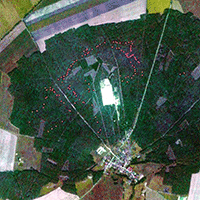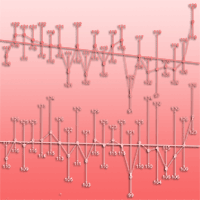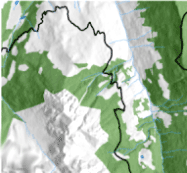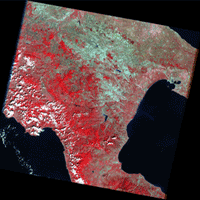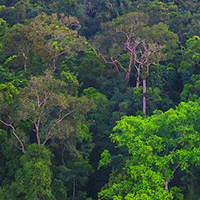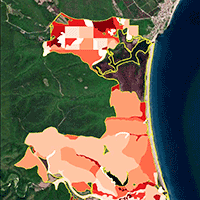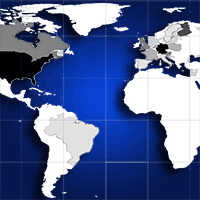
Remote sensing of Japanese beech forest decline using an improved Temperature Vegetation Dryness Index (iTVDI)
A Ishimura, Y Shimizu, P Rahimzadeh-Bajgiran, K Omasa
iForest - Biogeosciences and Forestry, Volume 4, Issue 5, Pages 195-199 (2011)
doi: https://doi.org/10.3832/ifor0592-004
Published: Nov 03, 2011 - Copyright © 2011 SISEF
Research Articles
Collection/Special Issue: COST Action FP0903 (2010) - Rome (Italy)
Research, monitoring and modelling in the study of climate change and air pollution impacts on forest ecosystems
Guest Editors: E Paoletti, J-P Tuovinen, N Clarke, G Matteucci, R Matyssek, G Wieser, R Fischer, P Cudlin, N Potocic
Abstract
The Tanzawa Mountains, which cover parts of Kanagawa, Yamanashi and Shizuoka prefectures in Japan, are known for their natural beech forests. Since the 1980s, decline of the beech forests, probably caused by air pollution, water stress and insect infestation, has become a serious problem. We estimated the natural beech forest mortality rate in the mountains by using multi-temporal 8-day composite data recorded at the MODIS instrument aboard the Terra satellite, daily air temperature data at meteorological stations (AMeDAS) in 2007, and a global digital elevation model obtained from ASTER aboard the Terra satellite. For the estimation, we used a Normalized Difference Vegetation Index (NDVI) indicating the vegetation density, a Temperature Vegetation Dryness Index (TVDI), and an improved TVDI (iTVDI) indicating the differences in transpiration rates between areas of similar vegetation density. We compared the NDVI, TVDI, and iTVDI maps with an existing mortality map of beech forests in the study area to verify their accuracy. To produce iTVDI maps, we calculated maps of air temperature by using ambient air temperature and elevation data. By interpolation using an environmental lapse rate, we calibrated air temperature maps with good accuracy (RMSE = 0.49 °C). The iTVDI map could detect mortality more accurately than the NDVI and TVDI maps in both spring and summer. Use of iTVDI enabled us to detect forest decline caused by air pollution and water deficits, inducing a reduction in transpiration rates. This index should be useful for monitoring vegetation decline.
Keywords
Decline, Forest, MODIS, Normalized Difference Vegetation Index (NDVI), Improved Temperature Vegetation Dryness Index (iTVDI)
Authors’ Info
Authors’ address
Y Shimizu
P Rahimzadeh-Bajgiran
K Omasa
Department of Biological and Environmental Engineering, Graduate School of Agricultural and Life Sciences, University of Tokyo, 1-1-1 Yayoi, Bunkyo-ku, 113-8657 Tokyo (Japan)
Corresponding author
Paper Info
Citation
Ishimura A, Shimizu Y, Rahimzadeh-Bajgiran P, Omasa K (2011). Remote sensing of Japanese beech forest decline using an improved Temperature Vegetation Dryness Index (iTVDI). iForest 4: 195-199. - doi: 10.3832/ifor0592-004
Paper history
Received: Nov 30, 2010
Accepted: Jul 20, 2011
First online: Nov 03, 2011
Publication Date: Nov 03, 2011
Publication Time: 3.53 months
Copyright Information
© SISEF - The Italian Society of Silviculture and Forest Ecology 2011
Open Access
This article is distributed under the terms of the Creative Commons Attribution-Non Commercial 4.0 International (https://creativecommons.org/licenses/by-nc/4.0/), which permits unrestricted use, distribution, and reproduction in any medium, provided you give appropriate credit to the original author(s) and the source, provide a link to the Creative Commons license, and indicate if changes were made.
Web Metrics
Breakdown by View Type
Article Usage
Total Article Views: 60522
(from publication date up to now)
Breakdown by View Type
HTML Page Views: 50590
Abstract Page Views: 3536
PDF Downloads: 4770
Citation/Reference Downloads: 28
XML Downloads: 1598
Web Metrics
Days since publication: 5151
Overall contacts: 60522
Avg. contacts per week: 82.25
Citation Metrics
Article Citations
Article citations are based on data periodically collected from the Clarivate Web of Science web site
(last update: Mar 2025)
Total number of cites (since 2011): 9
Average cites per year: 0.60
Publication Metrics
by Dimensions ©
Articles citing this article
List of the papers citing this article based on CrossRef Cited-by.
References
Remote sensing of vegetation. Oxford University Press, New York, USA, pp. 353.
Gscholar
Investigation of forest decline in the Tanzawa Mountain (1). Distribution of decline of Fagus crenata, Aies firma and other tree species. Reports of Forest Investigation Laboratory of Kanagawa, Japan 22: 7-18.
Gscholar
Diagnosis of stomatal response and gas exchange of trees by thermal remote sensing. In: “Air pollution and plant biotechnology” (Omasa K, Saji H, Youssefian S, Kondo N eds). Springer-Verlag, Tokyo, Japan, pp. 343-359.
Gscholar
Diagnosis of trees from helicopter by thermographic system. Environment Control in Biology 31: 161-168.
Gscholar
Comparative evaluation of the Vegetation Dryness Index VDI), the Temperature Vegetation Dryness Index (TVDI) and the improved TVDI (iTVDI) for water stress detection in semi-arid regions of Iran. (submitted for publication).
Gscholar
Monitoring vegetation systems in the great plains with ERTS. In: Proceeding of the “3rd ERTS Symposium”, NASA SP-351 1. U.S. Government Printing Office, Washington, DC, USA, pp. 309-317.
Gscholar
Current status of forest structure and decline of Japanese beech (Fagus crenatae) forests in the Tanzawa Mountains. In: “Reports of scientific investigation of Tanzawa-Oyama”. Institution of Scientific Investigation of Tanzawa-Oyama, The Hiraoka Environmental Science Laboratory, Kanagawa, Japan, pp. 479-484.
Gscholar
Integrated analysis for beech (Fagus crenata) forests restoration in the Tanzawa Mountains. In: “Reports of scientific investigation of Tanzawa-Oyama”. Institution of Scientific Investigation of Tanzawa-Oyama. The Hiraoka Environmental Science Laboratory, Kanagawa, Japan, pp. 703-710.
Gscholar

